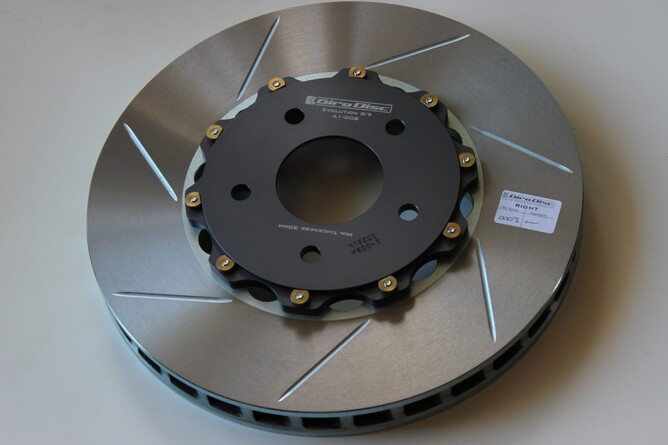Performance gains using two-piece discs
Last week we discussed the common advantages of switching to a two-piece disc setup using Girodisc, a great example on what product to use. (Click here for part one).
This week though, we're discussing the actual wheel horsepower performance gains you can expect to see from upgrading to two-piece discs.
This week though, we're discussing the actual wheel horsepower performance gains you can expect to see from upgrading to two-piece discs.
By switching from a one-piece disc to a two-piece disc you reduce the weight (inertia) of the disc because the Hat (or Bell) is typically made from aluminium. A reduction in rotational weight (especially unsprung rotational weight) has a significant impact on the driveline losses. You can actually increase wheel horsepower, because of the reduction of losses (explained below).
The engine doesn't make any more power, but you're sucking-up less energy with the weight of these components. Just the same as if you installed a lighter set of wheels or tyres.
As an example, a full set of Mitsubishi Evolution V–IX discs from Girodisc will save you around 6–6.5kg of rotational mass. Saving this much weight will net you around 8–12whp, depending on your current horsepower level.
Wheel horse power is the key term here. This has been proven on the dyno and it's something we'll be doing a controlled test of our own in the future.
Think of it as installing a lightweight engine pulley onto your vehicle – the reduced rotational mass improves horsepower as your engine doesn't have to work as hard to spin that lightweight component. Your brake system is no different, as it's connected to your engine so to speak. Yes, lightweight brakes can improve power too!
The engine doesn't make any more power, but you're sucking-up less energy with the weight of these components. Just the same as if you installed a lighter set of wheels or tyres.
As an example, a full set of Mitsubishi Evolution V–IX discs from Girodisc will save you around 6–6.5kg of rotational mass. Saving this much weight will net you around 8–12whp, depending on your current horsepower level.
Wheel horse power is the key term here. This has been proven on the dyno and it's something we'll be doing a controlled test of our own in the future.
Think of it as installing a lightweight engine pulley onto your vehicle – the reduced rotational mass improves horsepower as your engine doesn't have to work as hard to spin that lightweight component. Your brake system is no different, as it's connected to your engine so to speak. Yes, lightweight brakes can improve power too!
To take this to the next level, Girodisc has purposely made an "Ultralite" rotor option for the Evo V-IX chassis. They have specially made a casting with extra thin rotor cheeks by utilising a large air-gap disc. Girodisc have cut the disc weight, even more than their normal two-piece discs. This allows Drag-Racing drivers to enjoy the benefits of a lightweight disc without needing to replace their factory calipers.
On top of the great weight savings, Girodisc rotors feature a curved-vane internal construction for maximum cooling potential. This means the disc will act as a centrifugal pump when spinning, which helps draw air through the core of the disc.
This design reduces operating temperatures, which in turn optimises braking performance consistency. Couple this with brake ducting from the front of the car, and your disc will be at its optimum cooling capacity.
Most one-piece discs use a pillar method of casting which means they use the same casting for left and right discs. This is done to save costs for manufacturing and the end user, but with some sacrifice to cooling capacity and disc stability.
Questions on your current set up? We're happy to help. Get in touch with us here.
Next week we'll be discussing cost and serviceability, so stay tuned.
On top of the great weight savings, Girodisc rotors feature a curved-vane internal construction for maximum cooling potential. This means the disc will act as a centrifugal pump when spinning, which helps draw air through the core of the disc.
This design reduces operating temperatures, which in turn optimises braking performance consistency. Couple this with brake ducting from the front of the car, and your disc will be at its optimum cooling capacity.
Most one-piece discs use a pillar method of casting which means they use the same casting for left and right discs. This is done to save costs for manufacturing and the end user, but with some sacrifice to cooling capacity and disc stability.
Questions on your current set up? We're happy to help. Get in touch with us here.
Next week we'll be discussing cost and serviceability, so stay tuned.



